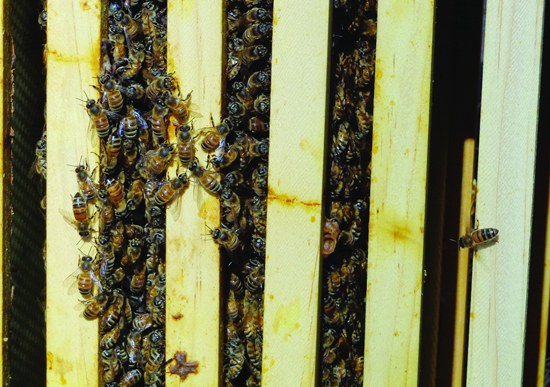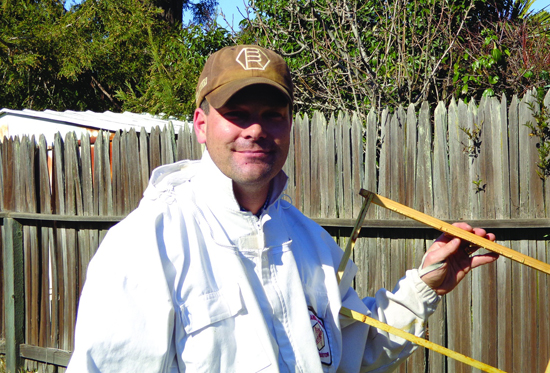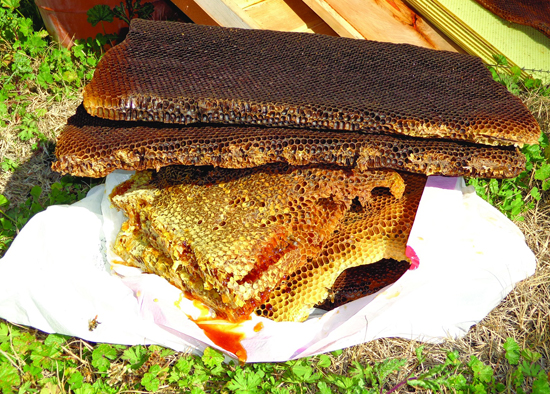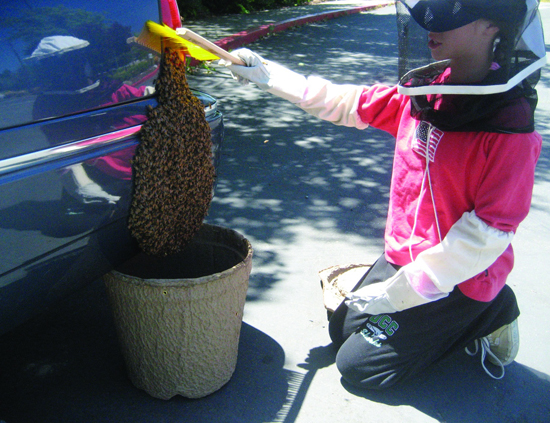 | | | Hive inspection Photos Cathy Tyson
| | | | | | Last year was challenging for Lamorinda bees. Mike Vigo, also known as the Bee Rancher, described 2012 as "one of the more difficult years of beekeeping," but he says he is looking forward to the spring nectar flow of 2013.
 Vigo was still relatively new to the honey business, having made a dramatic change from his prior career as a securities professional when we reported on him in June, 2012. He admits it's been frustrating. Since 2006, beekeepers throughout California and beyond have reported unexplained losses of hives. Despite many local hive impediments, "customers are very excited," said the ranch foreman. "They love the process."
Vigo was still relatively new to the honey business, having made a dramatic change from his prior career as a securities professional when we reported on him in June, 2012. He admits it's been frustrating. Since 2006, beekeepers throughout California and beyond have reported unexplained losses of hives. Despite many local hive impediments, "customers are very excited," said the ranch foreman. "They love the process."
 Publishers of the Lamorinda Weekly, Andy and Wendy Scheck had a hive setback over the winter. It was like Christmas morning when the hive was delivered last June, the homeowners ready for the new arrivals, with a wood bee box in a protected location that receives morning sun.
Publishers of the Lamorinda Weekly, Andy and Wendy Scheck had a hive setback over the winter. It was like Christmas morning when the hive was delivered last June, the homeowners ready for the new arrivals, with a wood bee box in a protected location that receives morning sun.
 The colony seemed to be thriving, but inexplicably, Andy Scheck said, "We were queen-less for a while and lost a good chunk of our bees." Thankfully Vigo had a spare colony, a new queen and drones that successfully merged; this was confirmed by a recent check-up visit by the Bee Rancher, who verified the colony was back on track.
The colony seemed to be thriving, but inexplicably, Andy Scheck said, "We were queen-less for a while and lost a good chunk of our bees." Thankfully Vigo had a spare colony, a new queen and drones that successfully merged; this was confirmed by a recent check-up visit by the Bee Rancher, who verified the colony was back on track.
 If all goes well, the Schecks should have a bountiful honey harvest in June and again in September.
If all goes well, the Schecks should have a bountiful honey harvest in June and again in September.
 Although the family enjoys home-grown honey, Scheck said his real goal is to keep the bee population up. Colony collapse disorder is a serious concern and having an ample bee population is critical to pollinate fruit and nut trees - especially almonds.
Although the family enjoys home-grown honey, Scheck said his real goal is to keep the bee population up. Colony collapse disorder is a serious concern and having an ample bee population is critical to pollinate fruit and nut trees - especially almonds.
 Visiting on an unusually warm day in mid-February, Vigo exclaimed the Schecks' hive looks fantastic with "evidence of a very prolific queen" - a positive sign, since a queen honey bee can lay up to 1,500 eggs per day. He predicts the population is really going to grow dramatically in the next month or so.
Visiting on an unusually warm day in mid-February, Vigo exclaimed the Schecks' hive looks fantastic with "evidence of a very prolific queen" - a positive sign, since a queen honey bee can lay up to 1,500 eggs per day. He predicts the population is really going to grow dramatically in the next month or so.
 One mite was found on visual inspection of the Schecks' hive, but there's always more, cautioned Vigo. Varroa destructor is an external parasitic mite, causing varroatosis by attaching to bees and sucking their blood. A colony can collapse if there's significant infestation. Options for dealing with mites run the gamut from doing nothing and hope the hive has strong genetics, to using an organic mite-away strip and beyond.
One mite was found on visual inspection of the Schecks' hive, but there's always more, cautioned Vigo. Varroa destructor is an external parasitic mite, causing varroatosis by attaching to bees and sucking their blood. A colony can collapse if there's significant infestation. Options for dealing with mites run the gamut from doing nothing and hope the hive has strong genetics, to using an organic mite-away strip and beyond.
 Vigo had been making his Bee Rancher rounds that day to one of the over 70 hives he manages, noting that the last hive he visited in Lafayette was "really cranking," describing the bees as very happy, in the sun all day, out of the wind, located on a hill, with lots of available pollen.
Vigo had been making his Bee Rancher rounds that day to one of the over 70 hives he manages, noting that the last hive he visited in Lafayette was "really cranking," describing the bees as very happy, in the sun all day, out of the wind, located on a hill, with lots of available pollen.
 Next stop for Vigo was a Moraga hive with unusual origins. Wild bees created a hive in one of the large wooden columns that flanked the front door - rather like a vertical, stinging non-welcome mat. The homeowners wisely asked for help; the very large column was removed in sections and eventually the bees ended up in a bee box in their back yard. They seem to be thriving - Vigo carefully transferred their original waxy combs into frames that are now safely away from the front door.
Next stop for Vigo was a Moraga hive with unusual origins. Wild bees created a hive in one of the large wooden columns that flanked the front door - rather like a vertical, stinging non-welcome mat. The homeowners wisely asked for help; the very large column was removed in sections and eventually the bees ended up in a bee box in their back yard. They seem to be thriving - Vigo carefully transferred their original waxy combs into frames that are now safely away from the front door.
 Bees hanging out on your car, or in your chimney? Swarm season is right around the corner, typically starting in mid-March and running through mid-June. It's a natural phenomenon that occurs when the colony senses that there is no more room for the existing amount of bees. The colony will then produce a sister queen, and, just before she hatches, the existing queen will leave the hive with about half the colony in search of a new home; this is how honey bees propagate.
Bees hanging out on your car, or in your chimney? Swarm season is right around the corner, typically starting in mid-March and running through mid-June. It's a natural phenomenon that occurs when the colony senses that there is no more room for the existing amount of bees. The colony will then produce a sister queen, and, just before she hatches, the existing queen will leave the hive with about half the colony in search of a new home; this is how honey bees propagate.
 "We try to manage the swarming process by splitting the hive into two colonies when we see a queen cup that has been formed and adding an additional hive box to the existing colony to give them more room," said Vigo.
"We try to manage the swarming process by splitting the hive into two colonies when we see a queen cup that has been formed and adding an additional hive box to the existing colony to give them more room," said Vigo.
 Fear not, though a swarm of bees can be frightening, they are actually at their most docile state because they don't have a home to defend and they have gorged themselves on honey. One might find a swarm of bees on a fence post, the bumper of a car, in a bush or on the branch of a tree; they will stay there until they find a new home.
Fear not, though a swarm of bees can be frightening, they are actually at their most docile state because they don't have a home to defend and they have gorged themselves on honey. One might find a swarm of bees on a fence post, the bumper of a car, in a bush or on the branch of a tree; they will stay there until they find a new home.
 Despite a tough winter, Vigo's business continues to prosper. He's currently taking orders for spring hives; for more information check the website at www.thebeeranchers.com or call (925) 519-0560.
Despite a tough winter, Vigo's business continues to prosper. He's currently taking orders for spring hives; for more information check the website at www.thebeeranchers.com or call (925) 519-0560.

|



